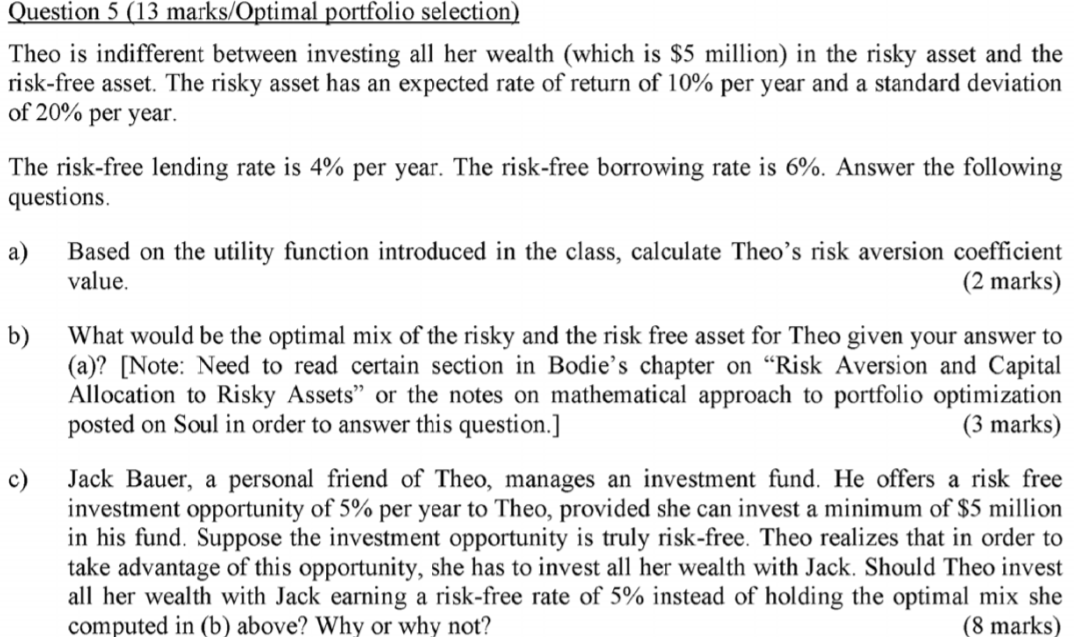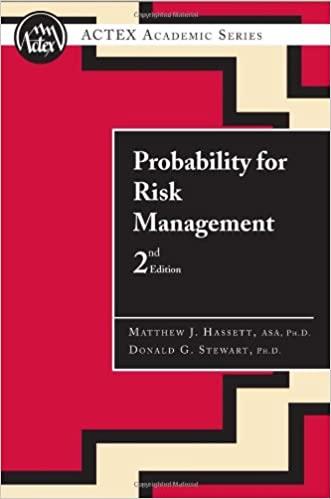
Question 5 (13 marks/Optimal portfolio selection) Theo is indifferent between investing all her wealth (which is $5 million) in the risky asset and the risk-free asset. The risky asset has an expected rate of return of 10% per year and a standard deviation of 20% per year. The risk-free lending rate is 4% per year. The risk-free borrowing rate is 6%. Answer the following questions. a) Based on the utility function introduced in the class, calculate Theo's risk aversion coefficient value. (2 marks) What would be the optimal mix of the risky and the risk free asset for Theo given your answer to (a)? [Note: Need to read certain section in Bodie's chapter on Risk Aversion and Capital Allocation to Risky Assets or the notes on mathematical approach to portfolio optimization posted on Soul in order to answer this question.] (3 marks) Jack Bauer, a personal friend of Theo, manages an investment fund. He offers a risk free investment opportunity of 5% per year to Theo, provided she can invest a minimum of $5 million in his fund. Suppose the investment opportunity is truly risk-free. Theo realizes that in order to take advantage of this opportunity, she has to invest all her wealth with Jack. Should Theo invest all her wealth with Jack earning a risk-free rate of 5% instead of holding the optimal mix she computed in (b) above? Why or why not? (8 marks) Question 5 (13 marks/Optimal portfolio selection) Theo is indifferent between investing all her wealth (which is $5 million) in the risky asset and the risk-free asset. The risky asset has an expected rate of return of 10% per year and a standard deviation of 20% per year. The risk-free lending rate is 4% per year. The risk-free borrowing rate is 6%. Answer the following questions. a) Based on the utility function introduced in the class, calculate Theo's risk aversion coefficient value. (2 marks) What would be the optimal mix of the risky and the risk free asset for Theo given your answer to (a)? [Note: Need to read certain section in Bodie's chapter on Risk Aversion and Capital Allocation to Risky Assets or the notes on mathematical approach to portfolio optimization posted on Soul in order to answer this question.] (3 marks) Jack Bauer, a personal friend of Theo, manages an investment fund. He offers a risk free investment opportunity of 5% per year to Theo, provided she can invest a minimum of $5 million in his fund. Suppose the investment opportunity is truly risk-free. Theo realizes that in order to take advantage of this opportunity, she has to invest all her wealth with Jack. Should Theo invest all her wealth with Jack earning a risk-free rate of 5% instead of holding the optimal mix she computed in (b) above? Why or why not? (8 marks)







